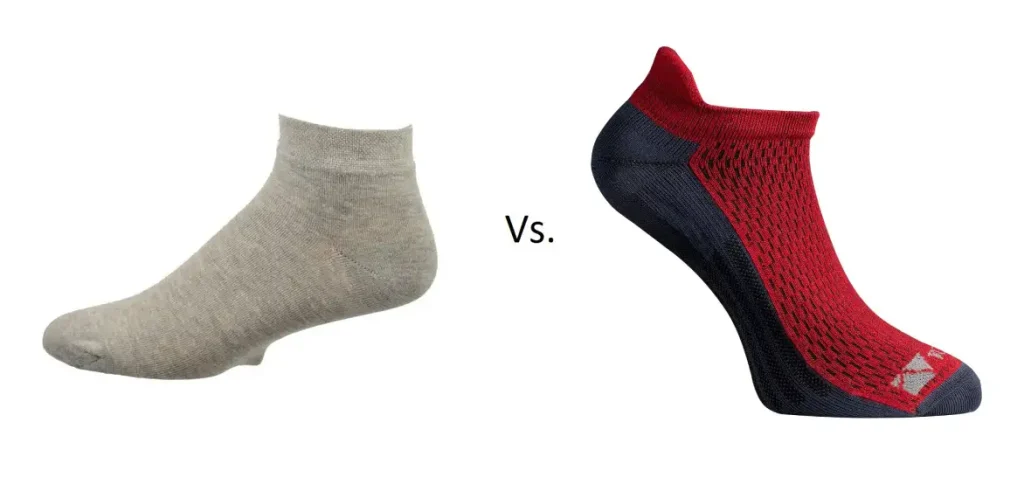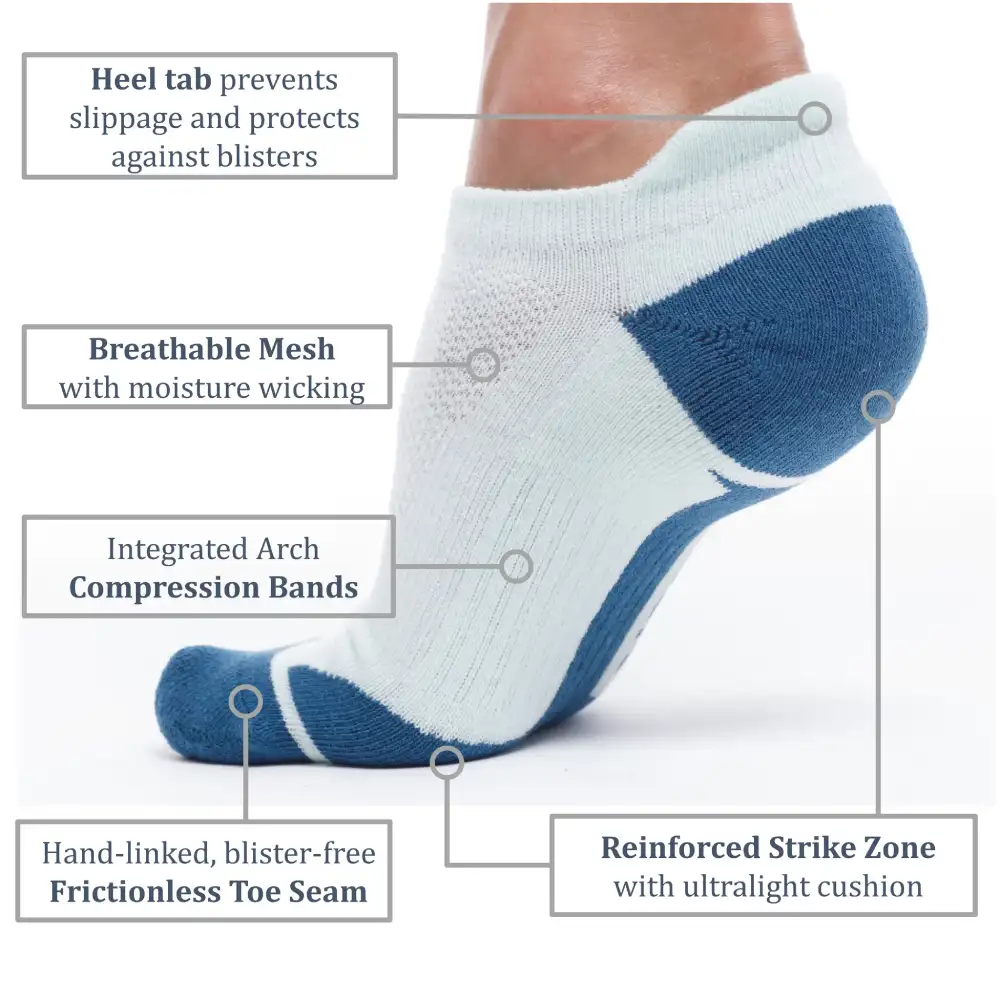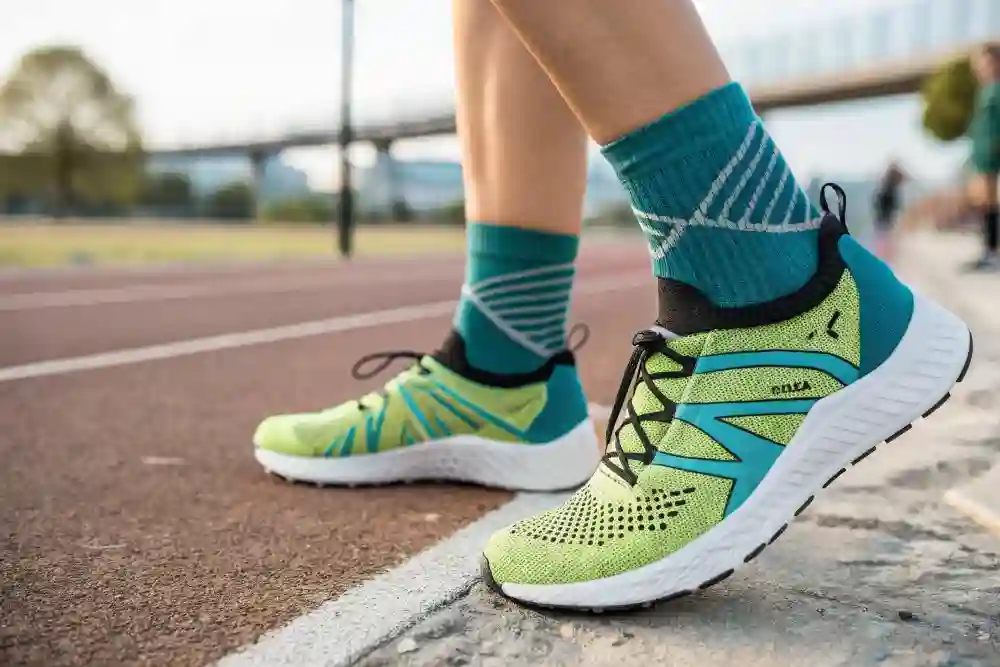Your store’s new athletic line launches, yet customers keep returning with complaints of sore feet and blisters. The hidden culprit isn’t always the sneakers—it’s often the everyday sock. These basic pairs can’t stand up to intense activity because they fail to provide the right blend of support, cushioning, and ventilation.
A properly designed running sock addresses these performance issues by emphasizing comfort and durability. If you’re looking to diversify your portfolio, offering high-quality solutions can set your brand apart in a crowded market. It’s not just about fabric and stitching; it’s also about unlocking a new opportunity to boost sales and long-term loyalty.

Running Socks vs. Normal Socks: What Your Customers Demand
Why Running Socks Use Advanced Fabrics
Many shoppers assume all footwear essentials are equal. Daily cotton pairs soak up sweat, break down under regular stress, and contribute to painful blisters. High-performance alternatives, however, use breathable synthetics or antibacterial merino wool to move moisture away from skin and offer greater durability. Stocking these can cut down on complaints about soggy feet or odor issues, making your store the go-to place for reliable athletic gear.
How Seamless Designs Prevent Foot Stress
Traditional socks often have thick seams that can irritate skin. Running-focused options use flat or minimal stitching, reduce friction, and incorporate reinforced heels and toes for extended wear. By offering these styles, you help your customers avoid discomfort and enjoy a better experience during workouts.
Targeted Support for Lasting Endurance
Plain socks frequently sag or slip, ignoring critical foot anatomy. Athletic varieties fix this with gentle compression bands that steady the arches, limit movement inside the shoe, and help prevent injuries. Runners who appreciate the difference in comfort tend to return for more, and gyms or clubs might place bulk orders to keep members happy.
The Science and Key Features Behind Running Socks
Well-crafted athletic footwear combines advanced materials and design elements to reduce friction, regulate temperature, and deliver support. Below are the core aspects that differentiate these from everyday options:
Moisture-Wicking Fabrics
- Why It Matters: Dry feet help prevent blisters and odors.
- What It Looks Like: Fibers like synthetic blends or merino wool that transport sweat to the outer layer.
Arch Support and Cushioning
- Purpose: Reduce strain and stabilize the foot during high-impact activities.
- Benefit: Helps runners maintain balance and reduce fatigue over long distances.
Odor Control and Antibacterial Properties
- How It Works: Special yarns inhibit bacterial growth, keeping socks fresher for longer.
- Advantage: Appeals to consumers who exercise regularly and don’t want lingering smells.
Thermal Regulation
- Hot and Cold Adaptability: Designed to keep feet cool in summer and warm in winter.
- Outcome: Versatile options that work for various climates and seasons.

Targeted Padding
- Location: Often placed under the forefoot and heel to absorb shock.
- Result: Reduces soreness, allowing athletes to go further with less discomfort.
Reinforced Heels and Toes
- Reason: Prolongs the sock’s life in areas that experience the most wear.
- Benefit: Fewer returns and a reputation for reliable quality.
Seamless or Low-Friction Construction
- Why It’s Needed: Thick seams can lead to chafing and blisters.
- Upside: Users experience less irritation, especially on long runs.
Compression Zones
Why Consumers Love It: Helps combat muscle fatigue, making workouts more comfortable.
What They Do: Apply mild pressure to increase blood flow and reduce swelling.
Why Normal Socks Fall Short for Athletes
When shoppers head to the gym or go for a run, plain cotton footwear often can’t keep up. It retains moisture, creates friction, and provides minimal arch support. As a result, users face fatigue, soreness, and an overall decrease in comfort. This lack of engineering also causes the fabric to break down quickly, which leads to more returns and dissatisfied buyers.
- The Cotton Trap: Cotton retains sweat, making feet clammy and prone to hotspots or raw skin.
- Lack of Targeted Support: Without structure, arches can collapse under stress, increasing the chance of discomfort and injury.
- Durability Failures: Basic pairs tear easily in high-impact areas like the toe and heel, causing frustration for both customers and businesses.

Running Sock Styles and Applicable Scenarios
Different athletes have distinct needs. Providing diverse cuts and specialized functionalities helps you address various training types, climates, and personal preferences.
Height-Based Running Sock Styles
- Toeless Socks: They allow extra breathability and natural foot movement, appealing to those who like a free-feeling stride.
- Ankle Socks: Lightweight and discreet, ideal for everyday road runs.
- Mid-Calf Socks: Designed for people who crave more support and light compression around the lower leg. Trail runners often appreciate this extra security on uneven paths.
- Over-the-Knee Socks: Ideal for staying warm and protected during snowy or chilly workouts. They offer coverage in tough climates, minimizing the need for layered clothing.

Function-First Running Sock Designs
- Cross-Country Socks: Durable and water-repellent, engineered for rocky or wet paths.
- Quick-Dry Socks: Built from synthetic fibers that shed sweat fast, perfect for those who tackle marathons or train in humid settings. Showcasing this benefit can appeal to athletes concerned about damp feet.
- Odor-Control Socks: Combining bamboo or wool with modern manufacturing methods helps maintain freshness through multi-day events. This solution appeals to customers looking for both comfort and cleanliness.
- Compression Socks: A must-have for individuals who cover long distances or struggle with muscle fatigue. Gentle pressure around the calf can improve blood flow, making these an attractive choice for endurance enthusiasts.
How to Choose a Running Sock for Your Brand
When you’re selecting specialized running socks for demanding customers, a thoughtful approach to materials, styling, and practical features is vital. Certain fibers, like merino wool, excel at managing odor and regulating warmth, while polyester or nylon handle sweat and friction effectively. Bamboo-based yarns can offer an eco-conscious edge, and elastic fibers like Lycra enhance stability by adapting snugly to each foot shape.
Material Selection
- Merino Wool: Manages odors and warmth.
- Polyester/Nylon Blends: Top-notch moisture-wicking and durability.
- Bamboo Fiber: Offers breathability and antibacterial benefits.
- Elastic Fibers (e.g., Lycra): Improves the sock’s overall fit.
Height & Function
- Ankle, Mid-Length, or Over-the-Knee: Match sock length to the environment and type of run.
- Quick-Dry and Odor-Control Variants: Essential for customers in humid or multi-day race settings.
Scenario Adaptation
- Road Running: Light, seamless structures.
- Trail Challenges: Thicker, wear-resistant fabrics.
- Cold Weather: Longer coverage with wool content for warmth.
Key Details
- Reinforced Zones: Durable fabric in toe and heel.
- Secure Fit: A snug yet breathable design avoids slipping or bunching.
- Additional Perks: Antimicrobial treatments and anti-friction pads.
By addressing these elements, you meet the needs of active individuals while elevating your brand’s value. Whether your customers tackle marathons or prefer easy strolls, offering diverse, quality footwear demonstrates your commitment to both performance and comfort.
Why Your Business Needs to Embrace Running Socks Now
Athletes and fitness enthusiasts are no longer settling for basic footwear. As demand for specialized gear grows, running socks stand out as a high-margin opportunity for brands aiming to lead in performance wear. By focusing on features like breathable nylon and seamless designs, you cater to shoppers seeking comfort during workouts while reducing return risks from blisters or poor durability.
Partnering with trusted manufacturers simplifies customization, letting you innovate with materials like antimicrobial yarns or eco-friendly packaging without delays. Certifications like OEKO-TEX® also act as quick trust signals, assuring customers of safety and quality. This approach not only cuts costs through direct production control but also builds loyalty by aligning with values like sustainability.
Conclusion
A thoughtful approach to running socks can elevate your brand’s reputation and satisfy a wide range of customer demands. By focusing on aspects like moisture control, arch support, targeted cushioning, and temperature management, you offer real benefits for active individuals.
If you’re ready to differentiate your catalog with premium, high-performance options, consider partnering with our foreign trade factory. We specialize in creating customized solutions that blend advanced features with your unique brand identity—helping you capture customer loyalty and thrive in a fast-growing market.
FAQs
Are Running Socks Worth the Investment?
Yes, specialized socks offer distinct advantages. When you include these high-performance options in your collection, you provide enhanced support and moisture management that appeal to active consumers. This investment can help you differentiate your brand and build lasting customer loyalty.
How Often Should Runners Replace Their Socks?
For optimal performance, you can suggest that athletes update their technical socks every few months, depending on how frequently they use them. This practice ensures that users maintain the support and comfort essential for preventing discomfort during workouts.
Can Running Socks Prevent Plantar Fasciitis?
While no product guarantees complete prevention, socks engineered with extra cushioning and targeted arch support can help reduce strain on the foot.
Can We Access Niche Materials Like Merino or Bamboo Fiber?
Yes. Many factories maintain relationships with specialized yarn suppliers. If you require specific fibers, communicate your preferences up front to confirm availability and lead times.
Are There Any Brand Protection Measures?
Non-disclosure agreements, trademark registrations, or design patents can safeguard your unique concepts. Discuss potential legal requirements or certifications early in the partnership.
